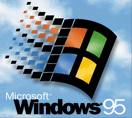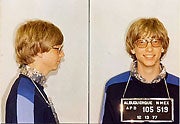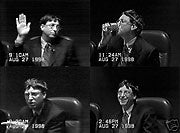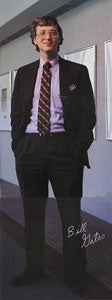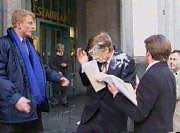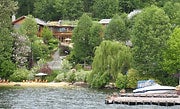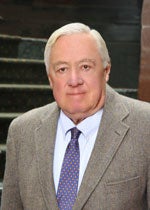
Technical specifications
General
Operating Frequency
* WCDMA2100 (HSDPA), EGSM900, GSM850/1800/1900 MHz (EGPRS)
* Automatic switching between bands and modes
Dimensions
* Volume: 90 cc
* Weight: 120 g
* Length: 99 mm
* Width: 53 mm
* Thickness (max): 21 mm
Memory Functions
* Up to 160 MB* internal dynamic memory for messages, ringing tones, images, video clips, calendar notes, to-do list and applications
* Memory card slot supporting up to 4 GB microSD memory cards
* Changes to product details are possible without prior notice. Application offering may vary. Dynamic memory means that the available memory is shared between dynamic memory functions. When any of these functions is used, there is less available memory for other functions which are also dependent on dynamic memory.
Power Management
* Battery: Nokia Battery (BL-5F) 950mAH
* Talk time: up to 160min (WCDMA), up to 240 min (GSM)*
* Stand-by time: up to 200 hours (WCDMA), up to 225 hours (GSM) *
* Operation times may vary depending on radio access technology used, operator network configuration and usage.
Displays
* Large 2.6" QVGA (240 x 320 pixels) TFT display with ambient light detector and up to 16 million colors
User Interface
* Operating system: S60 software on Symbian OS
* User Interface: S60 3.1
* Dedicated Media Keys
* Multimedia Menu
* Active standby screen
Call Management
* Contacts: advanced contacts database with support for multiple phone and e-mail details per entry, also supports thumbnail pictures and groups
* Speed dialing
* Logs: keeps lists of your dialed, received, and missed calls
* Automatic redial
* Automatic answer (works with compatible headset or car kit only)
* Supports fixed dialing number, which allows calls only to predefined numbers
* Conference call
* Push to talk (PoC)
Voice Features
* Speaker independent name dialing (SIND)
* Voice commands
* Voice recorder
* Talking ringtone
* Integrated hands-free speaker
Messaging
* Text messaging: supports concatenated SMS, picture messaging, SMS distribution list
* Multimedia messaging: combine image, video, text, and audio clip and send as MMS to a compatible phone or PC; use MMS to tell your story with a multi-slide presentation
* Automatic resizing of your megapixel images to fit MMS (max 300 KB size depending on the network)
* Predictive text input: support for all major languages in Europe and Asia-Pacific
Data Transfer*
* WCDMA 2100 (HSDPA) with simultaneous voice and packet data (PS max speed UL/DL= 384/3.6MB, CS max speed 64kbps)
* Dual Transfer Mode (DTM) support for simultaneous voice and packet data connection in GSM/EDGE networks. Simple class A, multi slot class 11, max speed DL/UL: 177.6/118.4 kbits/s
* EGPRS class B, multi slot class 32, max speed DL/UL= 296 / 177.6 kbits/s
*Actual achieved speeds may vary depending on network support.
Digital Services
* Java and Symbian applications available from Nokia Software Market
Imaging
Imaging
Imaging and Video
* Up to 5 megapixel (2592 x 1944 pixels) camera, Carl Zeiss optics, Tessar lens, MPEG-4 VGA video capture of up to 30 fps
* Direct connection to compatible TV via Nokia Video Connectivity Cable (CA-75U, included in box) or wireless LAN/UPnP
* Front camera, CIF (352 x 288) sensor
* Video call and video sharing support (WCDMA network services)
* Integrated flash
* Digital stereo microphone
* Flash modes: on, off, automatic, redeye reduction
* Rotating gallery
* Online album/blog: photo/video uploading from gallery
* Nokia Lifeblog 2.0 support
* Video and still image editors
* Movie director for automated video production
Mobile Video
* Video resolutions: up to VGA (640x480) at 30 fps
* Audio recording: AAC mono
* Digital video stabilization
* Video clip length: limited by available memory
* Video file format .mp4 (default), .3gp (for MMS)
* White balance: automatic, sunny, cloudy, incandescent, fluorescent
* Scene: automatic, night
* Color tones: normal, sepia, black & white, negative, vivid
* Zoom: Digital up to 10x (VGA up to 4x)
Mobile Photography
* Image resolution: up to 5 megapixel: (2592 x 1944 pixels)
* Still image file format: JPEG/EXIF
* Auto focus
* Auto exposure - center weighted
* Exposure compensation: +2 ~ -2EV at 0.5 step
* White balance: automatic, sunny, cloudy, incandescent, fluorescent
* Scene: automatic, user, close-up, portrait, landscape, sports, night, night portrait
* Color tones: normal, sepia, black & white, negative, vivid
* Zoom: Digital up to 20x (5 megapixel up to 6x)
Camera Specifications
* Sensor: CMOS, 5 megapixel (2592 x 1944)
* Carl Zeiss Optics: Tessar lens
* Focal length 5.6 mm
* Focus range 10 cm ~ infinity
* Macro focus distance 10-50 cm
* Shutter speed: Mechanical shutter: 1/1000~1/3 s
Music
Music
Music Features
* Digital music player - supports MP3/AAC/AAC+/eAAC+/WMA/M4A with playlists and equalizer.
* Integrated handsfree speaker
* OMA DRM 2.0 & WMDRM support for music
* Stereo FM radio (87.5-108MHz /76-90MHz)
Visual Radio*
* Listen to music and interact with your favorite radio stations
* Find out what song is playing, who sings it, and other artist information
* Enter contests and answer surveys, vote for your favourite songs
* Find out more about Visual Radio
* To check the availability and cost of the service, contact your network operator or service provider.
Explore
Explore
Navigation
* Built-in GPS
* Easy-to-use e-mail client with attachment support for images, videos, music and documents
* Compatible with Nokia Wireless Keyboard (sold separately)
Browsing
* Nokia Web Browser with Mini map
Digital home
* Play video, music and photos on home media network - compatible TV, stereo and PC over WLAN/UPnP
Java Applications
* Java MIDP 2.0, CLDC 1.1 (Connected Limited Device Configuration (J2ME))
* Over-the-air download of Java-based applications and games
Other Applications
* Personal Information Management (PIM)
* Advanced S60 PIM features including calendar, contacts, to-do list, and PIM printing
* Settings Wizard for easy configuration of e-mail, push to talk and video sharing.
* Data transfer application for transfer of PIM information from other compatible Nokia devices.
* Wlan wizard
Connectivity
* Integrated wireless LAN (802.11 b/g) and UPnP (Universal Plug and Play)
* Bluetooth wireless technology with A2DP stereo audio
* USB 2.0 via Mini USB interface and mass storage class support to support drag and drop functionality
* 3.5 mm stereo headphone plug and TV out support (PAL/NTSC)
* Nokia PC Suite connectivity with USB, Infrared and Bluetooth wireless technology
* Local synchronization of contacts and calendar to a compatible PC using compatible connection
* Remote over-the-air synchronization
* Send and receive images, video clips, graphics, and business cards via Bluetooth wireless technology
Video
Video
RealPlayer Media Player
* Full-screen video playback to view downloaded, streamed or recorded video clips
* Supported video formats : MPEG-4 , H.264/AVC , H.263/3GPP, RealVideo 8/9/10
Sales Package Contents
Sales Package Contents
* Nokia N95
* Nokia Video Connectivity Cable CA-75U
* Nokia Connectivity Cable DKE-2
* Nokia Stereo Headset HS-45, AD-43
* Nokia Battery BL-5F
* Nokia Travel Charger AC-5
Related Documents
Related Documents
* SAR
* Eco Declaration
* Declaration of Conformity
Specifications are subject to change without notice.
The availability of particular products and services may vary by region. Check with the Nokia dealer nearest to you.
Operations, services and some features may be dependent on the network and/or SIM card as well as on the compatibility of the devices used and the content formats supported. Some services are subject to a separate charge. For more information, contact your service provider.
The availability of the product and its features depends on your area and service providers, so please contact them and your Nokia dealer for further information. These specifications are subject to change without notice.




